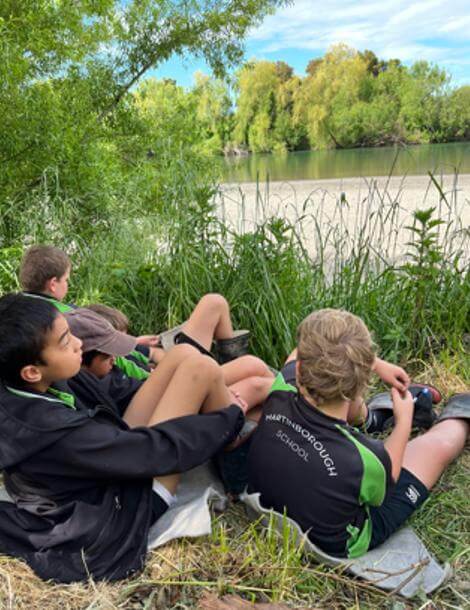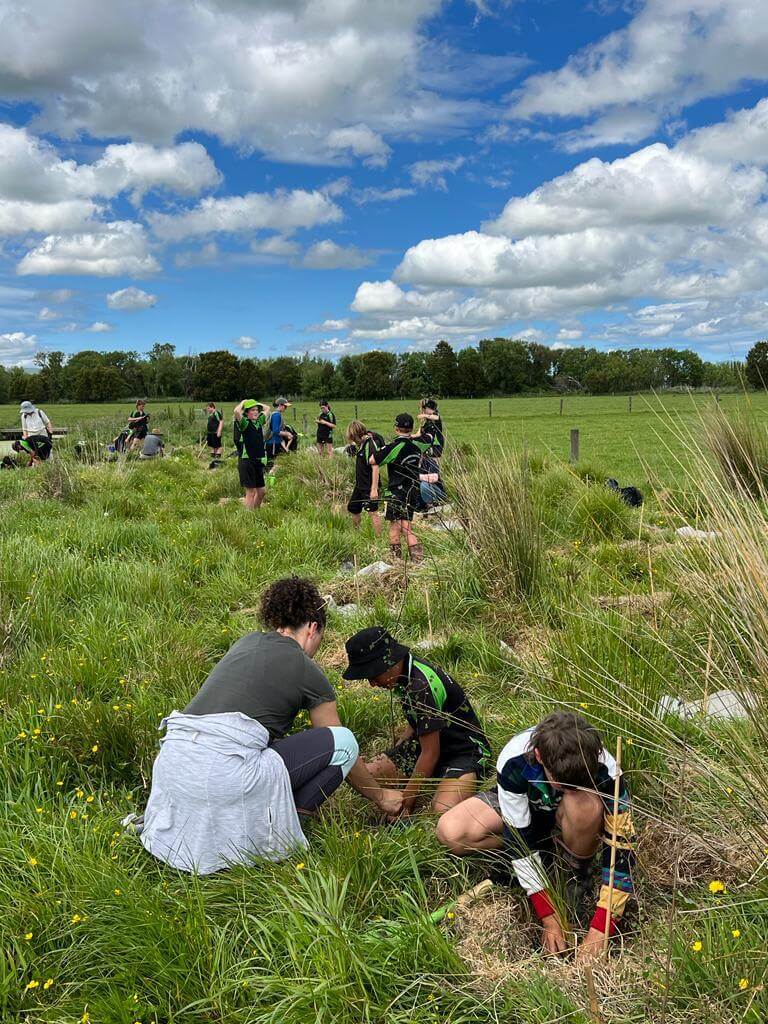Written by Jane Riddiford
My visits to the river have changed of late. I look at the recently planted understory in the old tī kōuka grove and am reminded of the many young hands from Martinborough school that eagerly carried piles of sheep dags to mulch around the trees. We hope their efforts will curb the force of the perpetually rising pasture grass, now this part of the farm is no longer grazed.
On the bank above the river with a good view of the water, we made a clearing, just big enough for the whole of the year six/seven class; 26 students in all. Before the physical mahi of the morning began we took time with all of them to ‘sit still’ . As we had hoped, the feeling of the place worked its magic and the class soon settled as they listened to what the river might have to say. Rod was co-hosting the visit with me and he shared a traditional story from the middle east about the challenges and ingenious twists and turns of a stream that figured out how to make it across the desert. This particular morning it was unexpectedly hot without a breath of wind. It was hard to imagine the raging torrent the Ruamāhanga can so often become; leaping over the bank we were sitting on, racing across the paddocks, dragging giant crocodile-like logs through the wetland, which we are now restoring in what was an old course of the river.

It was already November; late in the season to be planting. Fortunately the wetland now left to its own devices is holding more water and we found several suitably wet spots for the young people to plant manatu (ribbonwood) and kahikatea. These trees, generously donated by the Ruamāhanga Restoration Trust, would once have cloaked the swampy parts of our valley. We are preparing for a hot dry El Niño summer; not ideal growing conditions. The upside will hopefully be that in the wetland the roots of these trees will become established before the force of the next flood comes which might wash young saplings away. We also planted some of the many plants often generically referred to as mingimingi along with carex grass provided by the wetland team from the Regional Council. The young people worked hard. Despite struggling with the heat, they managed to get close to 150 plants in the ground. The number seemed fitting, as the week of the planting, Pain and Kershaw, our local buy anything store, was celebrating its 150 year anniversary, and the fact that it has been owned since the beginning by the same family. Thanks to Connor Kershaw, we were given enough planting spades for a whole class visit.
After the planting we picked our way through the boggy ground of the wetland. We pointed out how the waters of what was until recently little more than a farm ditch, had now begun to braid, forming islands where the pūkeko were nesting. With tools in hand and mud smeared across smiling faces we completed a loop back to the sheep yards where the bus, once again provided by Green Jersey Cycles, was waiting to take the group back to school. In the final circle everyone shared what they liked or learned about their wetland experience … the squelchy feeling of the muddy soil, doing something good for the future, learning about the story of what was once here, sitting quietly beside the river …were some of the things we heard.


A few days later Rod and I followed up with a visit to the school. Nine of the year 6 and 7 girls joined us for a written and spoken word session. We had been inspired by a powerful practice worked with by Ra Smith the Environment Manager for Kahungunu Ki Wairarapa. Several years ago Ra created an interview with the Ruamāhanga, where he wrote in an imagined first person voice of the river. It was an engaging way of highlighting all the changes people have brought to the quality of the water and the way the river flows; changes that have not been entirely positive. We wanted the group to imagine the journey of the Ruamāhanga, from its beginnings as a tiny droplet of water high up in the Tarurua Ranges, down into the plains, gathering debris and toxicity in populated urban and farming areas, redirected away from the Wairarapa Moana by a mechanical barrage and eventually out into the freedom of the sea. We encouraged the young writers to imagine themselves as the river starting as a tiny droplet of water … what did you feel? What did you hope for ? What changes did you go through? Below is a glimpse of what they imagined, to read more see here. Together they created a word bank describing the qualities of the river and through a process of free fall writing and supported speaking they became the voices of the Ruamāhanga. We were thrilled by their poetic imagination and their connection to the power and beauty of the natural world.
I felt scared for my journey but that didn’t stop me. I felt the shape of a river calling me but I didn’t know if it was actually calling me or if I imagined it – Marnie
I was becoming part of the river, it was just like it was in a dream looking after the fish that swam in my waters – Persia
I watched the tiny bright shining stream go far with beautiful rocks under clear water – Lena
As I made my way down the mountain I was collecting so many things. I decided that my goal was to reach the ocean, I wanted to be free – Marla
I am beautiful and shiny with tall trees on either side growing bigger and taller everyday, but there are still small pebbles sitting at the bottom of the water – Poppy
Now I am a raging rough river that plays a huge part in nature. I am shiny, independent and fresh – Sarah
I felt the people fishing for tuna in my waters and loved it. It made me feel important, like I have a purpose – Jamie
I love growing and being determined, I can get through anything. I am very curious and I give people and plants food and water – Sophie